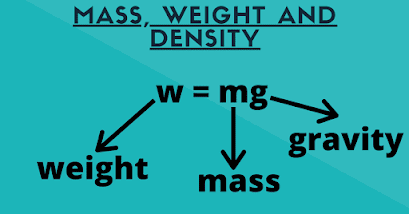The topic of mass, weight and density is very important in GCE O Level physics because this topic contains some really useful concepts.
So, let's start (from the beginning) without further introductions and let me explain these terms, like "mass" and "weight" to you in detail.
Before understanding the concept of mass and weight, you have to remember that these two quantities, mass and weight, and not similar. How are they different? Let me tell you.
What is mass?
Mass refers to the amount of matter in a body. In other words, mass is the quantity of matter in a body. Since this quantity does not change with the location or shape, mass remains the same everywhere.
For example, your mass on the earth and mars will be the same because the location will not affect the "quantity of matter" of a body.
Mass is measured in various units but the SI (international system of units) is the kilogram (kg). However, other units such as gram (g) are also used to measure mass.
Note: Although mass is explained (and even determined sometimes) as the weight of an object, these two quantities are not the same. This is because weight is a force while mass is a property. We will take a look at weight later in this article.
Therefore, mass is a property which does not change with either shape or location.
What is "weight"?
In physics, the weight of an object is the gravitational force (gravity) acting on it. This gravitational pull to each and every object in the universe is exerted by the earth.
The SI unit of weight is Newton (N) because this quantity is a force and the direction of this force (vector quantity) is downwards.
The concept of weight developed with the development of Newton's laws of motion. Moreover, you should also remember that the weight increases with the gravitational force.
For example, your weight on earth will be higher than on mars because the gravitational force of the earth is stronger as compared to that of mars.
The weight of an object is dependent upon its mass because the greater the mass, the greater the weight (gravitation force acting on the object) of the object.
You should also be familiar with some formulas to understand the relationship between mass and weight.
Force (Weight) = (mass) x (acceleration)
Similarly, you should also know that:
Weight (W) = mass (m) x gravity (g)
Now, you should also know that how do we measure weight and mass?
We have machines like spring balance and electronic balance to give us the weight of an object but these devices are calibrated to give readings in kilograms (kg) or grams (g).
However, this does not mean that these machines give us the mass of the object because they are only calibrated to do so.
Similarly, we measure mass with machines such as the beam balance which compares the gravitational force acting on the object (recall that weight is the gravitational pull acting on an object).
These were some basic concepts about weight and mass and let us summarize these concepts with some key differences between mass and weight.
The difference between mass and weight:
- Mass is the amount of matter in a body while weight is the gravitational force (pull) acting on the object.
- The SI unit of weight is Newton (N) while the SI unit of mass is the kilogram (kg).
- Weight is a vector quantity (has magnitude and direction) while mass is a scalar quantity (it only has a magnitude).
- We can measure mass with a calibrated electronic balance or beam balance while weight can be measured with a spring balance.
- Weight is dependent upon the location and shape while mass is independent of the location and gravitational field strength.
In this topic, you should also know that a gravitational field is a region where a mass has to experience gravitational attraction which comes as a force.
Inertia:
Mass is a measure of inertia and inertia is the reluctance of an object to change its position (during rest or motion) mainly because of its mass.
Let me make this simple for you. It is very difficult for an elephant to turn while moving because of its greater mass. However, a thin person can easily move and turn around because the mass is less.
You should also know that the greater the mass, the higher the inertia (reluctance or opposition). In simple words, inertia is the tendency to remain unchanged.
The concept of inertia is very important in physics mainly because this principle is used to elaborate on the motion of objects and how forces (acting on them) affect them.
Read:
These were some concepts which you should be familiar with and I have explained this term to you in detail so that you can easily manage questions related to this concept.
This takes us to another important topic in this chapter of mass, weight and density. So, let's dive into the topic.
Density:
When you divide the mass on an object by its volume, you get its density but this explanation is not enough to understand this topic.
In other words, density is mass per unit volume.
The SI unit of density is kilogram per cubic meter (kg/m³) and mathematically density is equal to the mass/volume.
It is to note that units such as gram per cubic centimetre can also be used to measure the density but these are not the SI unit of density.
To have a basic concept of density, keep in mind that the objects that float on the water have a lower density than water. Since the objects have a lower density than water, they float on water.
This was all about the topic regarding mass, weight and density but there are some practise questions for you to test your knowledge and prepare your exams.
Questions on mass, weight and density:
Question 1:
- An object has a volume of 2280 cm³ and a mass of 570 g. Calculate the density of this object.
Solution: density = mass/volume
density = 570/2280 = 0.25 g/cm³
Question 2:
- A bottle of cold drink has a mass of 0.5 kg and a density of 1000 kg/m³. Find the volume of the bottle, giving your answer in litres.
Solution: volume = 0.5/1000 = 0.0005 m³
To convert in litres, we multiply by 1000 and therefore, the answer will be 0.5 L (0.0005 x 1000).
Question 3:
- Metal A has a density of 3.2 g/cm³ and metal B has a density of 5.5 g/cm³. The metal C is made by combining metal A and B in the ratio of 3:7 respectively. Metal C has a mass of 2500 g so, what is the density of metal C?
Solution:
First of all, we will calculate the mass of metal A.
mass of metal A = (3/10) x 2500 = 750 g (because the mass of metal A is 3:10 to the mass of metal C).
Similarly, the mass of metal B will be = (7/10) x 2500 = 1750 g (because the mass of metal B is 7:10 to the mass of metal C as metal C is the combination of metal A and metal B).
Now, we have to calculate the volume of metal A and B.
The volume of metal A = mass/density = 750/3.2 = 234.38 g/cm³
The volume of metal B = mass/density = 1750/5.5 = 318.18 g/cm³
The volume of metal C = volume of metal A + volume of metal B = 234.38 + 318.18 = 552.56 cm³
Density of metal C = mass/volume = 2500/552.56 = 4.5 g/cm3
Question 4:
- On the moon, a book has a mass of 0.5 kg. This book is brought to the earth (the gravitational field on earth is stronger). On the earth, the book will have:
A. The same mass and more weight
B. The same mass and weight
C. The same weight and less mass
D. The same weight and more mass
Solution: Answer A (because since the gravitational field is stronger, the book will have more weight but the mass is not affected by the location).
Question 5:
- If the density of water is 1000 kg/m3, what is the mass of 1 cm3 of water in grams?
Solution: mass = density x volume
mass = 1 x 1 = 1 g (because 1000 kg/m3 is equal to 1 g/cm3 after conversion).
Conclusion:
With this, our topic about mass, weight and density has come to an end. I hope that all your questions are answered through this article.
Make sure to solve the practice questions given above and solve plenty of past paper questions to ace your examination. I hope that these notes were helpful for you and thank you very much for reading.



Comments
Post a Comment